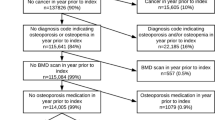Abstract
BACKGROUND: Recognition of incidental vertebral fractures may be an important opportunity for identifying and treating osteoporosis.
OBJECTIVE: To assess osteoporosis documentation rates in patients with vertebral fractures, and to define patient and hospitalization characteristics associated with osteoporosis management.
DESIGN: Hospital and outpatient records were abstracted for patients with vertebral fractures on inpatient radiograph reports. The primary outcome of interest was discharge summary fracture documentation. Covariates associated with fracture documentation and treatment were examined with multivariate regression models. Secondary outcomes included osteoporosis documentation and management 6 months following discharge.
PATIENTS: Women ≥ 50 years hospitalized at an academic medical center.
RESULTS: Among 10.291 women with chest radiographs, 142 (1.4%) had vertebral fractures reported. Among patients with a reported fracture, 58 (41%) had their fracture noted in the findings section but not in the final impression. Only 23 (16%) discharge summaries documented a vertebral fracture. Factors associated with documentation of the fracture in the discharge summary included notation of the fracture in the impression section (odds ratio [OR] 3.7, 95% confidence interval [CI] 1.0 to 13.1), tobacco use (OR 3.7; 95% CI 1.1 to 12.2), discharge from a medical service (OR 7.6; 95% CI 0.9 to 66.2) and glucocorticoid use (OR 3.7; 95% CI 0.8 to 17.0). Only 36% of patients were using any osteoporosis medications at discharge. Fracture notation in the impression section was associated with fracture documentation in subsequent outpatient notes (OR 3.6, 95% CI 0.9 to 13.8). Discharge summary fracture documentation was associated with an increased likelihood of starting an osteoporosis medication by 6 months (OR 2.8; 95% CI 0.8 to 9.2).
CONCLUSIONS: Incidental vertebral fractures from inpatient chest radiographs may represent a missed opportunity for osteoporosis management.
Similar content being viewed by others
References
Consensus development conference: diagnosis, prophylaxis, and treatment of osteoporosis. Am J Med. 1993;94:646–50.
Magaziner J, Simonsick EM, Kashner TM, Hebel JR, Kenzora JE. Predictors of functional recovery one year following hospital discharge for hip fracture: a prospective study. J Gerontol. 1990;45:M101–7.
Melton LJ, Atkinson EJ, Cooper C, O’Fallon WM, Riggs BL. Vertebral fractures predict subsequent fractures. Osteoporos Int. 1999;10:214–21.
Klotzbuecher CM, Ross PD, Landsman PB, Abbott TA III, Berger M. Patients with prior fractures have an increased risk of future fractures: a summary of the literature and statistical synthesis. J Bone Miner Res. 2000;15:721–39.
Black DM, Arden NK, Palermo L, Pearson J, Cummings SR. Prevalent vertebral deformities predict hip fractures and new vertebral deformities but not wrist fractures. Study of osteoporotic fractures research group. J Bone Miner Res. 1999;14:821–28.
Lindsey R, Silverman SL, Cooper C, et al. Risk of new vertebral fracture in the year following a fracture. JAMA. 2001;285:320–3.
Ross PD, Davis JW, Epstein RS, Wasnich RD. Pre-existing fractures and bone mass predict vertebral fracture incidence in women. Ann Intern Med. 1991;114:919–23.
Kado DM, Browner WS, Palermo L, Nevitt MC, Genant HK, Cummings SR. Vertebral fractures and mortality in older women: a prospective study. Arch Intern Med. 1999;159:1215–20.
Ross PD. Clinical consequences of vertebral fractures. Am J Med. 1997;103:30S-43S.
Melton LJ, III, Kan SH, Frye MA, Wahner HW, O’Fallon WM, Riggs BL. Epidemiology of vertebral fractures in women. Am J Epidemiol. 1989;129:1000–11.
World Health Organization (WHO Study Group). Assessment of fracture risk and its application to screening for postmenopausal osteoporosis: report of a WHO Study Group. World Health Organ Tech Rep Ser. 1994;843:1–129.
Harris ST, Watts NB, Genant HK, et al. Effects of risedronate treatment on vertebral and nonvertebral fractures in women with postmenopausal osteoporosis: a randomized controlled trial. Vertebral efficacy with risedronate therapy (VERT) study group. JAMA. 1999;282:1344–52.
Jacobsen SJ, Cooper C, Gottlieb MS, Goldberg J, Yahnke DP, Melton LJ, III. Hospitalization with vertebral fracture among the aged: a national population-based study 1986–1989. Epidemiology. 1992;3:515–8.
Haczynski J, Jakimiuk A. Vertebral fractures: a hidden problem of osteoporosis. Med Sci Monit. 2001;7:1108–17.
Majumdar SR, Kim N, Colman I., et al. Incidental vertebral fractures discovered with chest radiography in the emergency department: prevalence, recognition, and osteoporosis management in a cohort of elderly patients. Arch Intern Med. 2005;165:905–9.
Gehlbach SH, Bigelow C, Heimisdottir M, May S, Walker M, Kirkwood JR. Recognition of vertebral fracture in a clinical setting. Osteoporos Int. 2000;11:577–82.
Genant HK, Wu CY, van Kuijk C, Nevitt MC. Vertebral fracture assessment using a semiquantitative technique. J Bone Miner Res. 1993;8:1137–48.
Altman DG. Practical Statistics For Medical Research. New York, NY: Chapman & Hall; 1991.
Black DM, Cummings SR, Karpf DB, et al. Randomised trial of effect of alendronate on risk of fracture in women with existing vertebral fractures: fracture intervention trial research group. Lancet. 1996;348:1535–41.
Kim N, Rowe BH, Raymond G, et al. Underreporting of vertebral fractures on routine chest radiography. Am J Roentgenol. 2004;182:297–300.
Bellantonio S, Fortinsky R, Prestwood K. How well are community-living women treated for osteoporosis after hip fracture. J Am Geriatr Soc. 2001;49:1197–204.
American Association of Clinical Endocrinologists. American Association of clinical endocrinologists 2001 medical guidelines for clinical practice for the prevention and management of postmenopausal osteoporosis. Endocrine Pract. 2001;7:294–312.
National Osteoporosis Foundation. Physician’s Guide to the prevention and treatment of osteoporosis. Available at www.nof.org. Accessed July 31, 2004.
Neer RM, Arnaud CD, Zanchetta JR, et al. Effect of parathyroid hormone (1–34) on fractures and bone mineral density in postmenopausal women with osteoporosis. N Engl J Med. 2001;344:1434–41.
Reid IR, Brown JP, Burckhardt P, et al. Intravenous zoledronic acid in postmenopausal women with low bone mineral density. N Engl J Med. 2002;346:653–61.
Author information
Authors and Affiliations
Corresponding author
Additional information
The authors have no conflicts of interest to report.
This work was supported in part by Arthritis Foundation (Atlanta, GA), NIH DA 15507, NIH AR48264, NIH AR48616 (Bethesda, MD)
Rights and permissions
About this article
Cite this article
Morris, C.A., Carrino, J.A., Lang, P. et al. Incidental vertebral fractures on chest radiographs. J Gen Intern Med 21, 352–356 (2006). https://doi.org/10.1111/j.1525-1497.2006.00395.x
Received:
Revised:
Accepted:
Issue Date:
DOI: https://doi.org/10.1111/j.1525-1497.2006.00395.x




